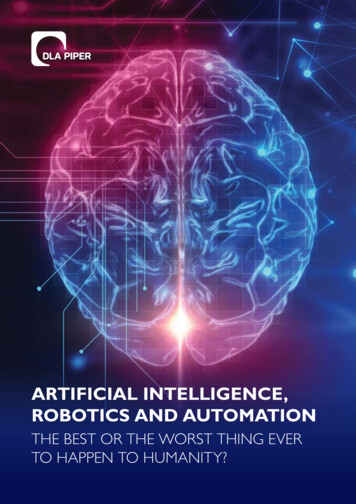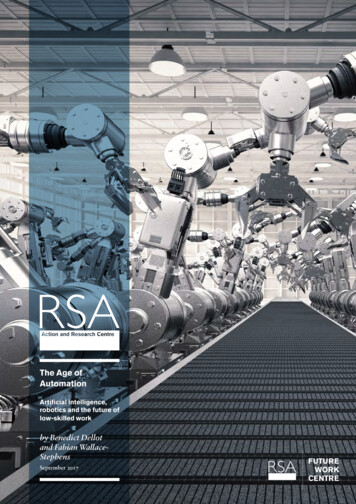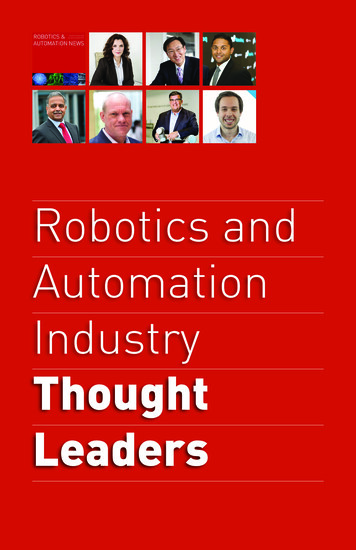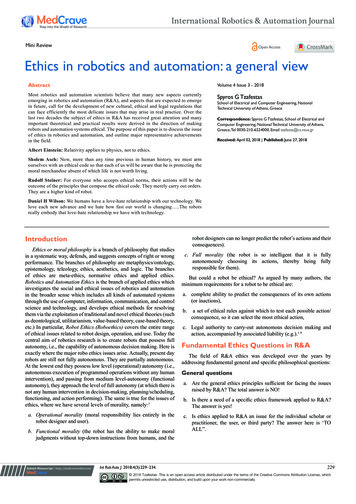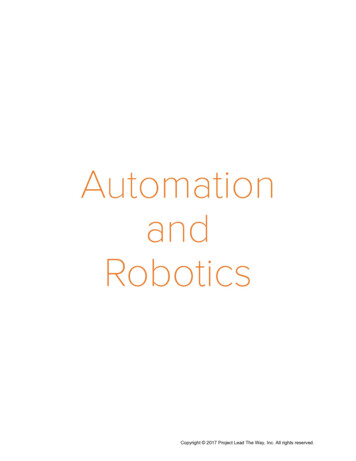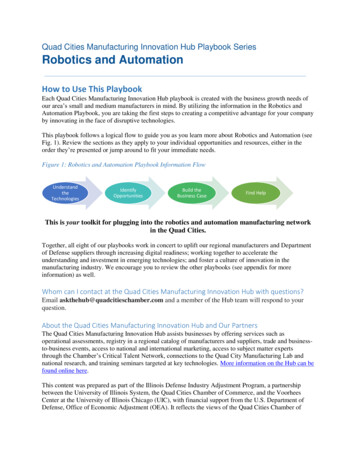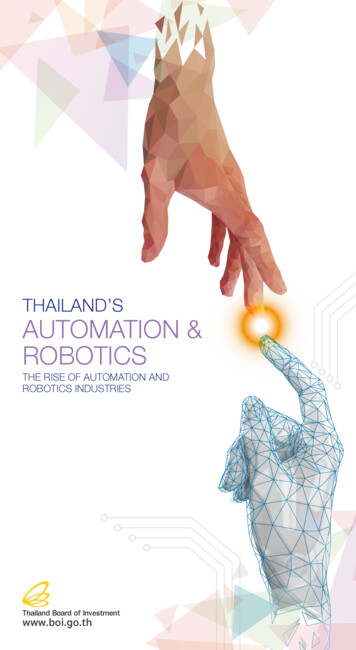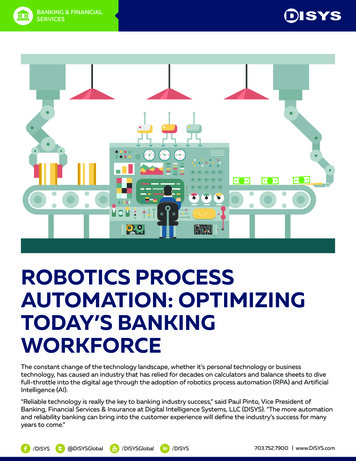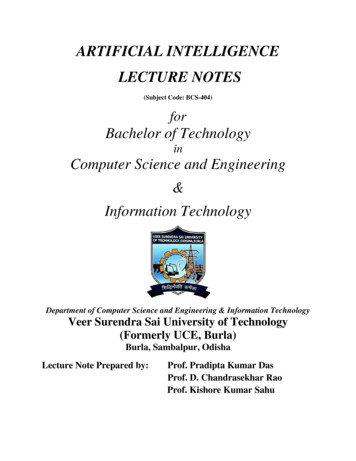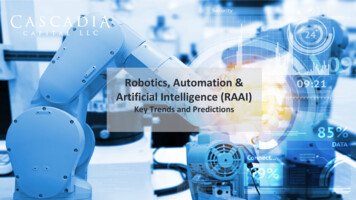
Transcription
Robotics, Automation &Artificial Intelligence (RAAI)Key Trends and Predictions
Table of Contents1. Executive Summary2. Technology Landscape3. Established and Emerging Leaders4. Investor Dynamics and Relevant Deals5. The Financing Gap6. Company Insights and ProfilesAppendix1. Cascadia Credentials and Team OverviewMember FINRA / SIPC2
ExecutiveSummary
Industry 4.0: Why Now?The 4th industrial revolution is the merging of the physical, digital and biological worldsINDUSTRY 4.0 TECHNOLOGY ADVANCEMENTHUMANS IN THE LOOPT o d a y , t h e 4 th i n d u s t r i a l r e v o l u t i o n i s u s i n g t h ebuilding blocks of computing and advancedtechnologies like artificial intelligence, deeplearning, computer vision, IoT, gene sequencing,energy storage, and blockchain to transform thephysical, digital and biological worlds - bringingcivilization to another level of automationArtificial intelligence will bring new levels ofefficiency, speed to market, preservation of resources,and human innovation. These steppingstones willcombine the capabilities of humans and AI and bringcivilization to the next stage with advances inhealthcare, energy, food, and moreAFFORDABLE COSTS & UNIQUEBUSINESS MODELSAutomation systems are becoming moreaffordable across industries as the growthof ‘service’ robots has adopted uniquebusiness models to reduce upfront costs.Thus, small to mid-size businesses can staycompetitive in the marketplace alongsidelarger blue-chip participantsCOST AND SCARCITY OF LABOR CREATEOPPORTUNITIES FOR AUTOMATIONSteady declines in labor coupled with risinglabor costs have become difficult limitingfactors across many industries. Prime examplesof these pain points are restaurant staff,agricultural labor, manufacturing workers, andan increase in laborer retirements in somemarkets. Automation is becoming the solutionfor wage pressure and productivity but moreimportantly, it is creating efficiency ofresources and opportunities for companies toadvance their position in the marketplace4
Industry Drivers and TrendsCOVID-19 &AutomationLabor Scarcityand CostCosts of Robotics& InnovationLeapsFactors DrivingAutonomyPolitical & SocialIncreased automation adoption in companies is enabling a distributed environment and creating solutions that minimize their costs, increase productivity, and protect theiremployeesThe current pandemic is accelerating the development and implementation of automation technologies, cloud computing, and data storage trends across industries asillustrated by over 50,000 warehouses making commitments to implementing robots and their supporting technologies by 2025US production, manufacturing, and non-supervisory labor has been declining at a rate of 11% since 1939 and is expected to continue this downward trend even as demandin e-commerce and shipping triples due to consumer interestStrong wage inflation and nationalist movements in developing nations reduces the cost efficiencies of outsourced manufacturing, driving businesses to re-shore productionwith the help of labor enhancing solutions like roboticsRobots, computation power, AI and situational awareness sensors like Lidar have all significantly decreased in cost and are demonstrating their ROI by increasingproductivity, lowering operating costs, and increasing manufacturing hours while providing companies security since a human is still “in the loop”Soft robotics is driving innovation in several biological and “light touch” use cases such as human hand replacement, climbing robots, edible robots, wearables, andprosthetics/robotic muscles, all of which are driving healthcare services and biomedical engineering forwardAutonomy is propelled by increasing costs and competition driven by factors such as larger retail shifts of goods now going to people, congestion in cities, climate change,and technical feasibility meeting specific activity needs across industries. Thus, as e-commerce volumes soar, many companies are turning to autonomy, robots, and AI todrive value in several end marketsImproving speed and accuracy in day-to-day operations in warehouses and manufacturing facilities, enabling autonomous vehicles and longer trucking hours, andmitigating risks of employee/human injury in unsafe environments, including mining, military and power maintenance and inspectionThe use of RAAI technologies drives several positive societal benefits, as well as externalities to address: Improving national competitiveness and growth of high-wage and high-skill labor, which has only been accelerated by global nationalist movements Increasing manufacturing productivity, exports, and value, while potentially fostering new machine tax programs and the need for a universal basic income to helpaddress labor redundanciesSource: Robotics and Automation News; FRED U.S. Manufacturing Production, and Non-Supervisory Labor5
Cascadia Near Term PredictionsDistributedEnvironments are KingSuccess in the MidwestDemocracy in ActionGood Things RollDown HillTrends in distributedmanufacturing will bedriven by companies thatwant to increaserevenues based on theirexisting infrastructureinvestments whileminimizing the gatheringof employees andexpensive centralizedfacilities. Thus, we expecthigh adoption of softwareand automationtechnologies that willprovide ways to enablesmaller, more distributedplants, connected by 5G.Once this occurs, we willsee major economic shiftsat scaleWe expect moreinnovation to come out ofhubs that have a lowercost of living, qualityacademic institutions,and more enablingpartnerships. Companiesthat have lower burnrates, talented teams,and powerful strategicpartnerships will propeltheir technology forwardat a faster rate inlocations between thecoasts like Pittsburgh,Columbus, Salt Lake City,Las Vegas, Kansas City,Denver, and AustinCompanies currentlyhave massiveunderutilized machinecapacity, especially inhubs like Pittsburgh andOakland that are limitedby their geography.Software platforms thatcan connect small andmid-sized businesses willdemocratize access, allowfor the reallocation ofinvestments that wouldhave been used for newinfrastructure, andenable cheapermanufacturing and betterutilization of capitalequipmentLarge-cap companies arealready heavilydependent onautomation, robotics ,andoptimizing softwaretechnologies and havesignificant investment inthe space, but we expectto see rapid expansiondown market asentrepreneurs findcreative ways to integratetheir products into SMEsvia unique businessmodels and servecustomer needs in bothstructured andunstructuredenvironmentsYou will be SurprisedSome of the mostinteresting technologiesare just now on the cuspof being commercializedand spun out from majorresearch universities suchas Carnegie MellonUniversity. Thesetechnologies are primedto perform better thanexisting marketparticipants, whilesurprising and delightingconsumers. The pace ofinnovation will continueto accelerate6
Robotics are Here and AcceleratingBusinesses invest in higher efficiencies, speed to market, and resource preservation by shifting to automationRAAI is integrating intoeveryday life across theglobe. Strategic buyers andinvestors alike are doublingdown in the sector, which isspanning a range of verticalsand end market applications,seen in the structuredenvironments of warehouseassembly lines, to theunstructured environmentsof farms, fast-foodrestaurants, and even intohomesEstimated Annual Shipments of Industrial Robots Worldwide000’ of units70013% p.a.6306005534845003812943002214% per annum20010042119% ** ForecastSource: International Federation of Robotics; McKinsey7
Scarcity of LaborDeclines in key warehousing, manufacturing, shipping, and other non-supervisory roles paired with the increasinge-commerce demand have companies adjusting operations to meet manufacturing and distribution goalsThe U.S. Manufacturing, Production, and Non-SupervisoryWorkforce is decreasing 000’ of PeopleE-commerce retail is still increasing and has hit all time highs,even before the effect of the COVID-19 pandemic. and futureexpected200012,430200510,06020108,078 8,000Declining at rate of 11% since 1939 140,000 120,000252%Growth 100,000 80,000 60,000 40,0002020 148,991 160,000All are in millionsdecreases are 42,285 20,000 020102019.leaders in e-commerce, such as Amazon, Walmart, UPS, and FedEx,are some of the largest end market adopters of robotics and have madegreat strides to augment their employee basesSource: FRED U.S. Manufacturing Production, and Non-Supervisory Labor; FRED E-commerce Retail data8
COVID-19 Drives Automation and DecentralizationEmerging automation technology is enabling the transition to a distributed environmentThe current pandemic isaccelerating the developmentand implementation ofautomation and enablingtechnologies across industriesto control disease spread whilealleviating COVID-19’s economicconsequencesAutomation has created fears ofsignificant job loss, but the useof automated and emergingtechnologies is primed topotentially create jobs, increaseproductivity, and grow marginsfor companies that are lookingto capitalize on the productivityof automation whiletransforming the capabilities oftheir employees to reach higherrevenue potential25%EducationGovernmentBusinessPersonal Care / ServicesRetailHeathcareTransportation / UtilitiesAllLeisure / HospitalityConstruction / ExtractionFinanceManufacturingInformation rcentage of WorkersConcerned About LosingTheir Jobs Due to COVID-1943%43%51%40%50%60%Automation will impact every sector of the economy and by 2030 it will have sparked some of the biggestgains in productivity and GDP per worker by industry55%40%7%5%45%35%6%6%Source: Ark Research; the RSA; Cascadia Proprietary Information47%47%53%50%32%6%6%7%6%4%% GDP Gain Per Worker 7%5%32%4%% GDP Gain per Worker 20309
Advancements in Unstructured EnvironmentsEnabling technologies are advancing robotic capabilities and providing move value to industries that lack structureRecent developments in machine vision,data processing power, and Lidar sensortechnology are allowing robots toventure further into unstructuredenvironmentsFor example, underwater exploration hasadvanced in tactile sensors andlocalization techniques have allowedAutonomously Guided Vehicles (AGVs) toexplore without the need for a surfacetether ship, greatly reducing cost.Simultaneous Location and Mapping(SLAM) has made use of heightenedsensor capabilities to take in troves ofdata from an unstructured underwater orabove ground environments, processingthat data to create a map of where thevehicle has been or of the surroundingenvironment and navigate itself forwardsinto the unknownSource: The Robot ReportSocial Interaction andIntelligence10 Largest Hurdles in Roboticsthat could have Breakthroughsin 5-10 yearsMedicalRoboticsPerception ,Manipulation &CreativityCapabilities ARMTechnologyNavigation &Exploration inUnstructuredEnvironmentsArtificial GeneralIntelligenceRobot Ethics &SecurityRobot SwarmsEnd market ValueValidation and FutureResponsibilitiesPower and Energy10
Strong End Markets: At a GlanceRAAI will bring key end markets to new levels of efficiency and advancementEnd markets inagriculture, energy,healthcare, supplychain, andtransportation stand tomake some of thebiggest gains fromimplementing RAAItechnologies due tothem having adisproportionate needfor human labor, as wellas key problems thatcan be addressed withavailable technologyAgricultureKey Problems Robotics, Automation, and AI can Solve: Scarcity of laborers Land limitations Lost yields due to climate changeAutomation Solutions Results: Increasing farmers yields Automated harvesting, picking, stone removal,mowing, pruning, seeding, etc.EnergyKey Problems Robotics, Automation and AI can Solve: Energy storage and distribution systems Efficiency and peak usage operation management T&D grid cannot sustain renewable energy generationAutomation Solutions Results: Increasing local energy generation and storage Regenerative and decentralized energy systems Connectivity and monitoring across gridsHealthcareKey Problems Robotics, Automation, and AI can Solve: Human error in procedures and diagnoses Early-stage disease detection and treatments Long hospitalizations, surgeries, and treatmentsAutomation Solutions Results: Reduce human error in high-risk procedures Decrease the time in surgeries/hospitalizations Improve patient recovery timeSupply ChainKey Problems Robotics, Automation, and AI can Solve:Automation Solutions Results: Higher labor costs from suppliers and manufacturers Efficiency in side-by-side work with humans Freight capacity and route efficiency Improving speed and accuracy of routine Employee retainmentoperations in warehousing/ manufacturingTransportationKey Problems Robotics, Automation, and AI can Solve: Large volumes of goods and materials on pre-definedroutes, in repetitive flows Traffic and route safetyAutomation Solutions Results: Logistical efficiency, improved flexibility Delivery precision Increased productivity11
Roadblocks and Hurdles Hindering End Market AdoptionCost and integration hurdles create barriers, but the market has shown its ability to overcome adoption challengesThe top challenges for end-useradoption are costs of purchasing robotsand the transition into automation.Challenges that follow are focused ontechnical integration and the “how isthis going to work” aspect as reflectedin concerns of integration acrossexisting platforms, lack of systemsintegrators, and lack of experience withautomating. That said, end marketadopters are learning to navigate thesechallenges as shown by the rise ininstallations of industrial robotsThere are still existing challenges suchas human acceptance, as illustrated byWalmart’s decision to end their contractwith Bossa Nova in part due to concernsthat shoppers were unnerved by largerobots roaming the retail floorCustomers Indicating Top and Top 5 ChallengesCost of Robots16%Lack of Integrated Platforms/ Interfaces13%Lack of Integrators across Industries12%General Lack of Experience with Automation15%Impossibility Retrofitting 3%Lack of Automated Solution for Problem9%Safety8%Cost of Training 2%18%Contracts with Existing Labor Force 3% 13%53%28%27%23%34%25%22%% Top ChallengeAnnual Installations of Industrial Robots‘000 of units2803002001000% Top 5 Challenges708931172010442011852641 28201243 302013Asia/AustraliaSource: International Federation of Robotics: World Robotics Report 2020; McKinsey; Wall Street Journal46 332014Europe2452001611349928350 38201556 412016674620177620185572482019Americas12
TechnologyLandscape
Technology LandscapeAs RAAI cuts across various sectors and end markets, civilization will realize significant advancement and new levels of innovation. Entrepreneursand industry leaders are combining these technologies to push automation forward to create a holistic and powerful digital and physicalmovementIncreased investment and opportunity cascades across multiple segments in RAAI landscapeSupply ChainRoboticsData Management & AnalyticsMobility Tech/AutonomyManufacturing & OperationsAutomationAugmented & Virtual RealityInternet of Things (IoT)Artificial Intelligence, MachineLearning & Computer VisionBlockchainDNA SequencingEnergy Storage14
Technology Landscape SubverticalsRobotics and AI create platforms for pioneers in automation, mobility, and integrative technologies to launch fromTechnology PlatformsRoboticsDronesIndustrial RobotsExploration RobotsConsumer RobotsMedical RobotsAerospace RobotsAquatic RobotsArtificial Intelligence &Machine LearningReinforcement LearningArtificial IntelligenceMachine LearningInteractive Voice ResponseMachine & ComputerNeural NetworksVisionNatural languageImitation LearningProcessingMulti-Agent LearningCognitive ComputingVoice RecognitionHuman ComputerImage RecognitionInteractionVideo SurveillanceDigital TwinningSelf-Supervised LearningUnsupervised LearningApplications & Supporting TechnologyMobility Tech/AutonomyAutonomous VehiclesPedestrian VehiclesAutomated TruckingCommuter TransportationAutonomous ForkliftsLast Mile Delivery Bots5G & TelematicsLidarData Management & AnalyticsFraud & SecurityIntelligenceData VisualizationData MiningPredictive AnalyticsData MonitoringTelematicsMapping & ImagingSoftwareCloud ComputingAR/VRAugmented RealityVirtual RealitySaaS/Software thatsupports AR/VRManufacturing & OperationsAutomation3D printingProgrammable AutomationFlexible AutomationCobotsAssembly & InspectionSoft RoboticsFactory RobotsProcessing OperationsAdditive Manufacturing Distributed ManufacturingVision and Optical Scanningand FulfillmentDeep LearningMaterials HandlingRobotic Process AutomationFixed AutomationInternet of ThingsEnergy ManagementSecurity & SurveillanceSupply Chain ManagementFleet ManagementInventory and Warehouse Building Management andOptimizationFacility ManagementIndustrial AssetCustomer Order & DeliveryManagementTrackingSmart ProductsNote: Blockchain, DNA Sequencing, and Energy Storage are excluded from this analysis due to the use of different technologies15
Representative End Market LandscapeRAAI companies are innovating across organized and unpredictable environments to create efficienciesStructured EnvironmentsBulk Handling Systems &WarehousesPrecision ElectronicsEnergy & UtilitiesManufacturing AssemblyLinesMining, Oil & GasExtractionUnstructured EnvironmentsAG Field & FoodAerospace and DefenseConstructionConsumer & RetailHealthcare & Digital HealthE-Commerce & FulfillmentFactoriesFinance, Investment &InsuranceGuarding and RoboticSecurity AutomationRestaurantSupply ChainTransportation16
Establishedand EmergingLeaders
Established InnovatorsVerticalRepresentative CompaniesAI/ML/Computer VisionAR/VRBlockchainData Management &AnalyticsDNA SequencingEnergy StorageIoT18
Established InnovatorsVerticalRepresentative CompaniesMobility Tech/AutonomyManufacturing &Operations AutomationRobotsSupply Chain19
Emerging LeadersVerticalRepresentative CompaniesAI/ML/Computer VisionAR/VRBlockchainData Management &AnalyticsDNA SequencingEnergy StorageIoT20
Emerging LeadersVerticalRepresentative CompaniesMobility Tech/AutonomyManufacturing &Operations AutomationRobotsSupply Chain21
Key Geographies Accelerating RAAI – Tier 1Silicon Valley, CA9,000 StartupCompanies2,000 RAAICompanies 55.5BBoston, MA1,780 StartupCompanies650 RAAICompanies 10.3BPittsburgh, PA600 StartupCompanies250 RAAICompanies 3.2BInvested in RAAI between2017-2021 (YTD)Invested in RAAI between2017-2021 (YTD)Invested in RAAI between2017-2021 (YTD)Silicon Valley has anestablished culture offostering startups,providing talent throughStanford University, andabundance of potentialinvestors to fuel growthBoston is seeing a surge instartups supported by toptalent from MIT, plenty offunding opportunities froma robust VC community,and has a history ofroboticsPittsburgh is home to“robotics row” andsupported by an abundanceof talent from CarnegieMellon, and new investorslike Amazon and Boschinvesting in the citySource: Pitchbook data; Cascadia Proprietary Information22
Key Geographies Accelerating RAAI – Other LeadersAustin, TX2,300 StartupCompanies750 RAAICompanies 5.6BLos Angeles, CA2,350 StartupCompanies650 RAAICompanies 7.6BSeattle, WA1,590 StartupCompanies550 RAAICompanies 6.4BInvested in RAAI between2017-2021 (YTD)Invested in RAAI between2017-2021 (YTD)Invested in RAAI between2017-2021 (YTD)Austin is home to some ofthe fastest growingoperations of Google andFacebook, and is supportedby a well-educatedworkforce and plenty ofcost incentives that lowerthe price of doing businessLos Angeles is an ideal placefor startups because thecity has easy access tocapital, a community ofentrepreneurs, and worldclass research universitieslike Caltech and UCLASeattle has moved past thegiant shadows of Microsoftand Amazon and is home toAI and cloud tech startupswith access to UWengineers, idea drivenprofessionals, and thesupporting capitalSource: Pitchbook data; Cascadia Proprietary Information23
InvestorDynamicsand RelevantDeals
Venture Capital Investment Drives InnovationsInvestments in RAAI will be crucial for enabling commercialization opportunity and creating product traction470 12,000 10,000318 8,000346600564500438278 12,031 6,000 0 1,083 1,35020152016 3,0482017Capital Raised 5,309 3,9742018Deals Transacted300200 4,000 2,000400# of deals( in millions) 14,000201920201000RAAI had record investments in 2019, seeing 203% growth in the total amount raised from 2018 to 2019. There will be a significantneed for follow-on fundraising rounds in the near-termVenture Capital Investment In Robotics (2013-2018)Beyond Robotics Hardware, the total market for robot systemsaccounts for 48B 3-8% Software andProgramming55%US 11B25%China 5B20% 5-8% Installation 48 BILLION 14-16% Robot Armwithout EOATRest of the World 4B100% 20BSource: IFR World Robotics, McKinsey Expert Interviews; Pitchbook data 10-12% AuxiliaryHardware100% 48B 12% Robot Accessories25
Automation is Driving Productivity and InvestmentStructured Environments: The growth inthe robotics sector and its supportingverticals has been opening into moredirect end markets within both structuredand unstructured environments. Withinstructured end markets, bulk handlingsystems, manufacturing, and warehousescontinue to be leading the demand curvefor robotics and automation technologyfollowed by electronics and energyUnstructured Environments: We haveseen RAAI venture investment into asuite of unstructured end markets. Weexpect demand to come from ecommerce and retail, fulfillment, foodservices, agriculture, and healthcare asmore autonomous robots drive growthEstimated Investments in Key End Markets and Their Relative SegmentsProjected Investment by 2025-2030 in BillionsAgricultureMining, Oil & Gas, and Utilities 26Real Estate & Construction 22 1 5 17Manufacturing 31 7Wholesale & Retail TradeTransportation and WarehousingFinance, Insurance and Information 267BTotal 24 4Company Management & Professional ServicesAdministrative and Waste Management 41 19Educational ServicesHealthcare and Social Assistance 12 14 15 14 15Arts & EntertainmentHospitality and Food ServicesOther ServicesGovernmentDNA SequencingSource: Ark Research; Investing News Network; Cascadia Proprietary Information26
Notable Venture Capital FinancingsThe market is seeing robust investments across various RAAI subsectors for market leadersAugmented RealityArtificial IntelligenceMobility TechManufacturing Automation 100mm 40mm 290mmGene SequencingMobility TechManufacturing Automation 450mm 46mm 100mmArtificial IntelligenceMobility TechManufacturing Automation2019 245mmRobotics2020 20mmRobotics2020 72mm 32mmGenome Testing2021 100mmSource: Pitchbook data 36mmCryptocurrency 25mm 2.5B 52mmMobility Tech 100mm 50mmManufacturing Automation 40mm27
Notable M&A TransactionsLarger established companies are extremely active in acquiring emerging leaders to maintain competitive advantageRoboticsArtificial IntelligenceMobility TechManufacturing Automation2019 5.8B 100mm 410mm 1.4B 1.1B 200mm 1.3B 24mm 1.1B (Announced)Undisclosed 8B (Announced) 35B20202020 - 2021Source: Pitchbook data28
Notable Corporate Investments, PIPE & IPOCorporations are making sizable investments in RAAI companies to capture growth and expand product & service linesPIPETargetBuyer 1.6B 150mm 1B 107mmAnalyticsMobility TechArtificial IntelligenceAnalyticsOctober 2020July 2020February 2017September2016 77mmUndisclosed 382mm 220mmMobility TechRobotics/Computer VisionRoboticsRobotics/HealthCareApril 2019April 2019March 2019March 2019IPO (Announced)IPON/A 28mm 230mm 44mmRoboticsAnalyticsInternet of ThingsMobility TechDec 2020Sep 2020May 2019July 2018Source: Pitchbook data29
A Rise in SPAC TransactionsSPACs have boomed since the latter half of 2020 and have focused on opportunities across the RAAI spectrumExperienceInvestmentCorp2020CIIG MergerTuscanHoldingsSwitchbackEnergyAcquisition 825mm 2.5B 5.4B 2.0BUrban Air MobilityAdvanced ManufacturingElectric VehiclesEnergy StorageChargingNov 2020Oct 2020Sep 2020Dec 2020ArcLight2021TrineAcquisitionsCorpDec 2020ChurchillCapital IVVPC ImpactAcquisitionHelo Corp. 1.6B 15.0B 2.1B 88mmElectric VehiclesElectric VehiclesCryptocurrencyWearable Devices &Digital HealthJan 2021Jan 2021Jan 2021Source: Pitchbook dataJan 2021 2.4BTS InnovationAcquisitionsCorp 1.6BIoTJan 202130
SPACs Place Bets on Automotive Lidar CompaniesLidar has seen strong SPAC interest, though the winners of this race are far from clearColonnadeAcquisitionCorp.CollectiveGrowth 1.9B 1.4BAutonomous Vehicles (Lidar)Autonomous Vehicles (Lidar)Dec 2020Dec isition 600mm 155mm 2.1BAutonomous Vehicles (Lidar)Autonomous Vehicles (Lidar)Autonomous Vehicles (Lidar)Dec 2020July 2020Nov 2020Source: Pitchbook data31
The FinancingGapEarly-stage robotics companies facechallenges of competing with larger,established companies in the space.Smaller companies vying for capitalmust demonstrate an ultra-competitivevalue proposition in order to receivefunding from investors
Capital Intensive with High Cash BurnMore robotics companies are positioning as softwareproviders, using off the shelf third party hardwarecomponents to deliver their serviceThe most widely cited challenge is the cost of robotsespecially because of limited standardization acrossbuyers, scarcity in certain robotics parts, and highproduction costs. Funding alone also does notguarantee success, as demonstrated by companies suchas ReThink Robotics and Airware, who both hadinvestments of over 100M but eventually ran out ofcash and shutdownAverage deal size has been increasing as robotadoption increases industry wide in millions 90 80.02 80 7019.63% CAGR 60 41.12 50 43.40 40 23.19 30Raising money is essential for companies to scale andinnovate but the decision often requires them to havethe right strategic or financial partner to help guidethem through the landscape. Overall, roboticscompanies are raising more per round to fund businessneeds 20 23.44 21.77 12.38 10 0Source: Robotics Business Review; Pitchbook data; Cascadia Proprietary Information201520162017201820192020202133
Lowering Costs of Robots and Increasing Use CasesRobotics companies with lower levels of revenue canhave strikingly high ARR multiples. There appears tobe a noticeable difference at the 2mm revenuemark. Projections and expectations are drivingvaluations for post-seed robotics companies ratherthan current er Acquisition CostCustomer Acquisition CostAnnual Revenue per RobotAnnual Revenue per UserRobot Lifetime ValueCustomer Lifetime Value(S&M Hardware Cost) / (ARR2 x Gross Margin)Number of CustomersAnnual RevenueNumber Robots DeployedSource: Pitchbook data; Silicon Valley Bank; Cascadia Proprietary Information400x350x300x250x200x150x100x50x0x(S&M) / (ARR2 x Gross Margin)Number of CustomersAnnual RevenueNumber of CustomersAnnual Revenue per RobotAnnual Robot Decommission rateARR MultipleAs stated in Wrights Law, robots are experiencing asteady cost decline as a function of increasingcumulative production. One of the ways roboticscompanies are decreasing costs is by utilizing arobotics as a service (RaaS) business model. Theproduct is rented or leased, often charged by thehour, to the customer for a defined period. RaaSoffers adoption options for many middle-marketcompanies especially because the RaaS model shiftsthe technology adoption risk from the customer tothe investors. However, as noted, a drawback of thismodel is it often requires larger amounts of fundingfrom investors to support manufacturing costs andthe cash cycleAnnual Revenue per UserUser Churn RateARR and ARR Valuation Multiple - Robotics Hardware CompaniesEarly Stage 0 1 2 3Later Stage 4ARR ( in Millions) 5 6 7 834
Key Qualities Buyers/Investors SeekEmerging companies should demonstrate that they possess several key attributes to attract investors/buyers tocomplete large capital raise transactions or strategic salesInnovationDefensible Technology Differentiated Protected IP Low risk forobsolescence Platform independentProof of ConceptProduct ViabilityCustomer ValidationCommercial ViabilityStrongCommercializationPotential Development of Pilot programs with key Synergistic with buyer Address key industry Customer ability to Buyer channel to marketsuccessful prototypesissues / obstaclescustomersarticulate eachcompany’s valuepropositionproduct offeringthat can scale eachcompany’s productLargeAddressable Market Tangible and focusedmarket that is at thebeginning of theadoption curve Significant growthopportunities thatcreate potential valuefor buyer35
CompanyInsights andProfiles
Investor Profile: The Robotics HubA Profile of The Robotics Hub with Chris MoehleLocation: Pittsburgh, PAOpportunityYear Founded: 2015Brief Overview:The world's first fund aimed at activelycreating companies of consequenceout of emerging roboticsbreakthroughs. They use Pittsburgh’sunique resources to develop and fosterorganizations that will one dayredefine the way we live and work.Their investment approach is designedto rapidly identify the most viable ideasand strategies, concentrate resourcesaround them, and get the strongestideas quickly to their growth phase byproviding a level of active supportmuch closer to that of co-founderChristopher (Chris) MoehleManaging Director“ one of the phrases we put on our website and other locations is “Companiesof Consequence” because if something is literally not a societal level challenge,I think you're not being ambitious enough.”“ banks are becoming big adopters of AI and robotics. If you look at the largestmarket cap companies on Earth, they are all spending heavily on robotic
Automation Labor Scarcity and Cost Costs of Robotics & Innovation Leaps Factors Driving Autonomy Political & Social US production, manufacturing, and non-supervisory labor has been declining at a rate of 11% since 1939 and is expected to continue this downward trend even as demand in
